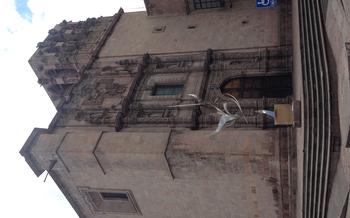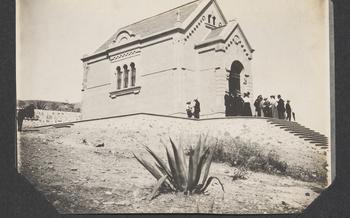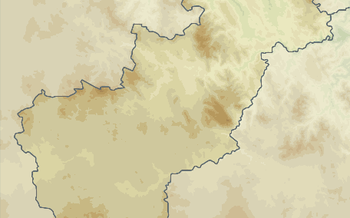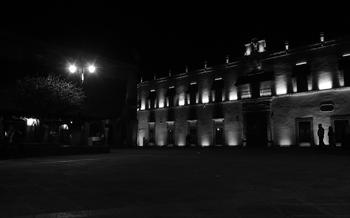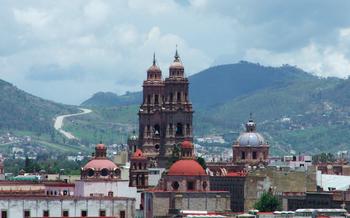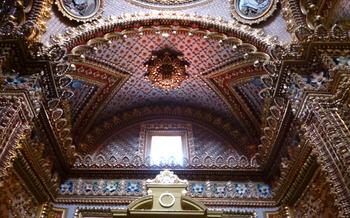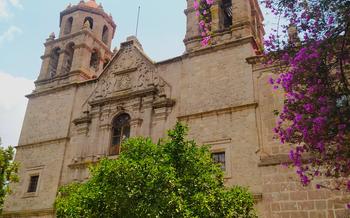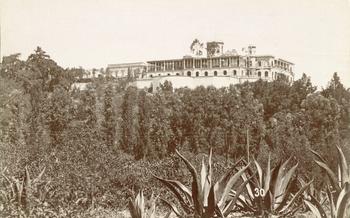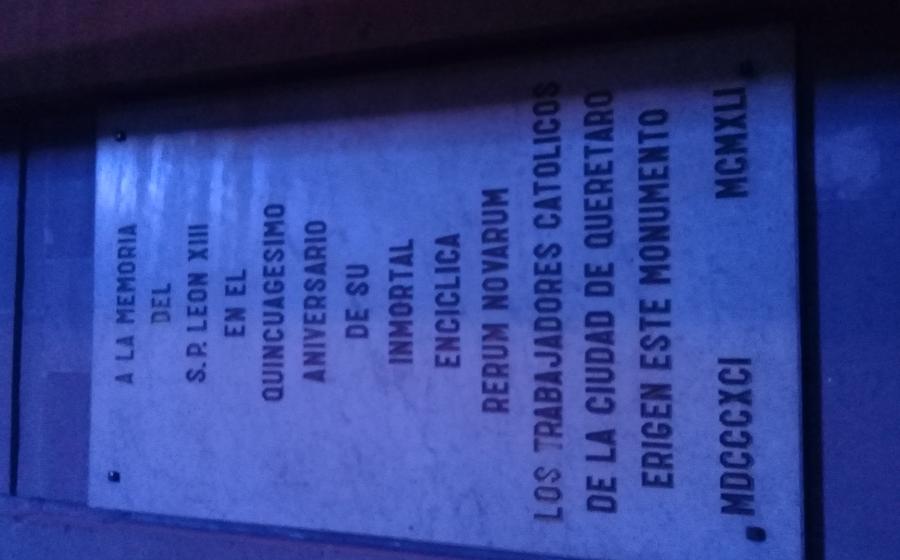
Queretaro Cathedral
- Queretaro Cathedral: A Majestic Tapestry of History and Faith
- Location and Accessibility
- Architecture and Design
- Landmark Status
- Religious Significance
- Interior Features
- Historical Events
- Guided Tours
- Local Festivals and Celebrations
- Pilgrimage Site
- Cultural Significance
- Photography and Videography
- Dress Code and Etiquette
- Nearby Attractions
- Insider Tip:
Queretaro Cathedral: A Majestic Tapestry of History and Faith
Standing as a testament to Mexico's rich history, Queretaro Cathedral holds a prominent place in the heart of the city. Its construction began in 1531, shortly after the Spanish conquest, and took over two centuries to complete. The cathedral's architectural style blends Gothic, Baroque, and Neoclassical elements, showcasing the evolution of artistic influences over time. Its majestic facade features intricate carvings and sculptures, while its interior boasts breathtaking murals, stained glass windows, and intricate altarpieces. The cathedral's historical significance is further solidified by its designation as a UNESCO World Heritage Site, recognizing its outstanding universal value.
Location and Accessibility
Queretaro Cathedral is situated in the heart of the historic center of Queretaro City, a UNESCO World Heritage Site. Its exact address is Calle Miguel Hidalgo 3, Centro, 76000 Santiago de Querétaro, Qro. The cathedral is conveniently located within walking distance of other notable landmarks, such as the Plaza de Armas, the Government Palace, and the Teatro de la República. Accessibility to the cathedral is excellent, with public transportation options such as buses and taxis readily available. For those traveling by private vehicle, parking is available in the nearby Plaza Constitución parking lot. The cathedral is wheelchair accessible, ensuring that all visitors can experience its grandeur.
Architecture and Design
Queretaro Cathedral, a masterpiece of Baroque and Neoclassical architecture, stands as a testament to the city's rich cultural heritage. Its facade, adorned with intricate carvings and sculptures, narrates the stories of saints and biblical scenes. The cathedral's interior, equally captivating, features soaring vaults, elegant columns, and a stunning altarpiece crafted from gold-plated wood. The intricate detailing and harmonious proportions of the cathedral's architecture create a sense of awe and wonder that leaves visitors mesmerized. The use of local materials, such as pink sandstone and volcanic rock, adds a distinctive character to the cathedral, blending seamlessly with the surrounding cityscape. Overall, the architectural grandeur of Queretaro Cathedral is a testament to the skill and artistry of the master builders who brought this magnificent structure to life.
Landmark Status
Queretaro Cathedral's exceptional historical and cultural significance has been recognized by UNESCO, the United Nations Educational, Scientific and Cultural Organization. In 1996, the cathedral was inscribed as a UNESCO World Heritage Site, joining a prestigious list of landmarks worldwide. This designation highlights the cathedral's outstanding universal value and the importance of preserving its unique architectural and religious heritage for future generations.
The criteria that led to Queretaro Cathedral's UNESCO recognition include its exceptional architectural style, which blends Gothic, Baroque, and Neoclassical elements, creating a unique and harmonious ensemble. The cathedral's interior is equally impressive, boasting intricate carvings, stunning stained glass windows, and a magnificent altarpiece.
Queretaro Cathedral's designation as a UNESCO World Heritage Site is not only a testament to its architectural and historical significance but also a symbol of the city's rich cultural heritage. This recognition places the cathedral among other UNESCO World Heritage Sites in Queretaro, such as the historic city center and the nearby Franciscan Missions, highlighting the city's importance as a cultural and religious center in Mexico.
Religious Significance
Queretaro Cathedral holds immense religious significance as a center of worship and spirituality for the Catholic community in Mexico. It serves as the seat of the Roman Catholic Archdiocese of Queretaro, overseeing a vast network of parishes and faithful throughout the region. The cathedral is a place of pilgrimage for devotees seeking spiritual guidance and blessings, particularly during significant religious events and celebrations.
The cathedral's grand interior provides a sacred space for various religious rituals, ceremonies, and masses. It hosts regular services, including daily masses, Sunday masses, and special masses on holidays and feast days. Devotees gather within the cathedral's hallowed walls to offer prayers, receive sacraments, and celebrate their faith in a communal setting.
The cathedral also plays a crucial role in fostering religious education and outreach within the community. It hosts catechism classes, workshops, and retreats to deepen the understanding of the Catholic faith among believers of all ages. By promoting religious knowledge and spiritual growth, the cathedral contributes to the preservation and transmission of Catholic traditions in Queretaro and beyond.
Interior Features
The interior of Queretaro Cathedral is as awe-inspiring as its exterior. The spacious nave, flanked by elegant aisles, leads the eye towards the grand altar, a masterpiece of Baroque art. Intricate carvings, gilded embellishments, and vibrant paintings adorn every surface, creating a sense of awe and devotion. The stained glass windows, depicting scenes from the Bible and the lives of saints, bathe the interior in a kaleidoscope of colors, casting an ethereal glow on the marble floors. The cathedral's collection of artwork includes paintings, sculptures, and tapestries from renowned Mexican artists, each piece contributing to the rich cultural and artistic heritage of Queretaro.
Historical Events
Queretaro Cathedral has witnessed numerous significant historical events throughout its existence. In 1848, the Treaty of Guadalupe Hidalgo was signed within its walls, marking the end of the Mexican-American War and the cession of vast territories from Mexico to the United States. This pivotal event left an indelible mark on the history of both nations and shaped the geopolitical landscape of North America.
Another notable event that took place in the cathedral was the coronation of Emperor Maximilian I and Empress Carlota in 186This lavish ceremony, steeped in imperial grandeur, symbolized the rise of the Second Mexican Empire. However, the empire's reign was short-lived, and Maximilian's execution in 1867 marked the end of this ambitious chapter in Mexican history.
The cathedral has also played a significant role in religious and social movements. In the 19th century, it served as a refuge for liberal and reformist thinkers during the tumultuous period of the Reform War. These individuals sought sanctuary within the cathedral's walls, finding solace and protection from the conflicts that raged outside.
These historical events have left an enduring legacy on Queretaro Cathedral, transforming it into a living testament to Mexico's rich and complex past. Visitors can immerse themselves in the echoes of history as they explore the cathedral's sacred spaces, marveling at the stories and characters that have shaped the nation's destiny.
Guided Tours
Queretaro Cathedral offers guided tours that provide visitors with an in-depth understanding of its history, architecture, and religious significance. These tours are conducted by knowledgeable guides who share fascinating insights into the cathedral's past and present.
The tours typically cover the cathedral's exterior and interior, highlighting notable features such as the intricate carvings on the façade, the stunning stained glass windows, and the impressive altar. Guides also share stories about the people and events that have shaped the cathedral's history, bringing its rich heritage to life.
Guided tours are available in various languages and can be booked in advance or on-site. Visitors are encouraged to take advantage of this opportunity to gain a deeper appreciation for Queretaro Cathedral and its role in Mexican history and culture.
Local Festivals and Celebrations
Queretaro Cathedral serves as a focal point for various local festivals and celebrations that showcase the city's vibrant culture and traditions. One of the most significant events is the annual Feast of Our Lady of Guadalupe, held on December 12th. This religious festival draws thousands of pilgrims and devotees who come to pay homage to the Virgin of Guadalupe, Mexico's patron saint. The cathedral becomes a hub of activity, with processions, masses, and other festivities taking place throughout the day.
Another notable celebration is the Queretaro International Mariachi Festival, held annually in August. This festival brings together talented mariachi bands from across the country and beyond, showcasing their musical prowess and paying tribute to this iconic Mexican tradition. The festival fills the streets of Queretaro with vibrant music, colorful costumes, and lively performances, creating a festive atmosphere that attracts locals and tourists alike.
These festivals and celebrations offer visitors a unique opportunity to immerse themselves in the local culture and traditions of Queretaro. By participating in these events, visitors can gain a deeper understanding of the city's rich heritage and the deep devotion of its people.
Pilgrimage Site
Queretaro Cathedral holds a significant place as a pilgrimage site for devout Catholics from across the region. Throughout the year, pilgrims flock to the cathedral to pay homage to the revered image of the Virgin of Guadalupe, a sacred icon deeply ingrained in Mexican religious tradition. The cathedral serves as a spiritual sanctuary, where pilgrims gather to offer prayers, seek blessings, and find solace in their faith. The pilgrimage to Queretaro Cathedral is not merely a religious journey but also a cultural and historical experience, as pilgrims immerse themselves in the stories and traditions that have shaped this sacred site.
Cultural Significance
Queretaro Cathedral holds immense cultural significance as a symbol of Mexican identity. It embodies the nation's rich history, religious traditions, and artistic heritage. The cathedral's distinctive architectural style, intricate artwork, and historical significance have earned it a place as a cherished landmark in the hearts of Mexicans.
Throughout the centuries, the cathedral has played a crucial role in shaping Queretaro's cultural landscape. It has been a witness to countless religious ceremonies, festivals, and celebrations, leaving an indelible mark on the city's cultural fabric. The cathedral's iconic presence has inspired local artists, musicians, and writers, who have drawn upon its beauty and history to create enduring works of art.
Beyond its religious and architectural significance, Queretaro Cathedral serves as a vibrant cultural hub, hosting concerts, exhibitions, and other cultural events that celebrate the city's diverse heritage. These events bring together locals and visitors alike, creating a sense of community and shared cultural identity.
The cathedral's cultural significance extends beyond Queretaro's borders, as it represents the rich tapestry of Mexican culture on a national and international scale. Its inclusion on the UNESCO World Heritage List recognizes its outstanding universal value and its contribution to the world's cultural heritage.
Photography and Videography
Queretaro Cathedral welcomes photography and videography enthusiasts to capture the beauty and grandeur of its architecture and interiors. However, visitors should be mindful of the following guidelines to ensure respect for the sanctity of the cathedral:
-
Flash photography and tripods are not permitted inside the cathedral. These devices can be disruptive to religious services and damage delicate artwork and artifacts.
-
Videography is allowed with prior permission from the cathedral authorities. Visitors who wish to film or record within the cathedral should contact the cathedral office in advance to obtain the necessary permits.
-
It is important to be respectful of the privacy of other visitors and avoid capturing them in your photographs or videos without their consent.
-
The best lighting conditions for photography are typically in the morning or late afternoon, when the natural light illuminates the cathedral's exterior and interior features.
-
Visitors are encouraged to share their photos and videos of Queretaro Cathedral on social media, using the hashtag #QueretaroCathedral, to inspire and connect with other travelers and history enthusiasts.
Dress Code and Etiquette
When visiting Queretaro Cathedral, it is important to dress appropriately and respectfully. As a sacred place of worship, the cathedral requires visitors to adhere to a certain dress code. While there is no strict dress code, modest attire is generally expected. Avoid wearing shorts, tank tops, or revealing clothing. For men, long pants and a collared shirt are appropriate, while women can opt for a dress, skirt, or pantsuit.
Beyond attire, visitors should also be mindful of their behavior and etiquette within the cathedral. This includes maintaining silence and refraining from talking or causing any disturbances during religious services or ceremonies. It is also important to respect the sanctity of the cathedral and avoid any actions that may be seen as disrespectful or disruptive. By observing proper dress code and etiquette, visitors can contribute to the peaceful and reverent atmosphere of Queretaro Cathedral.
Nearby Attractions
Queretaro Cathedral is surrounded by a wealth of cultural and historical attractions that visitors can explore before or after their visit. Just a short walk away is the Plaza de Armas, the city's main square, which features stunning colonial architecture, lively cafes, and vibrant street performers. Visitors can also explore the Museo Regional de Querétaro, which houses a collection of pre-Columbian artifacts, colonial-era paintings, and modern art.
For those interested in history, the Templo de San Francisco and the Templo de Santa Rosa de Viterbo are must-visits. These 17th-century churches showcase exquisite Baroque architecture and offer a glimpse into the city's rich religious heritage.
Nature enthusiasts can escape the city's hustle and bustle at the nearby Cerro de las Campanas, a hilltop park that offers panoramic views of Queretaro and the surrounding valley. The park is also home to the Templo de la Cruz, a small chapel that offers a serene retreat from the city.
To experience the local flavors of Queretaro, visitors can head to the Mercado de la Cruz, a traditional market where they can sample regional delicacies such as enchiladas queretanas, gorditas, and nopales en penca. The market also offers a variety of souvenirs and handicrafts, making it a great place to pick up unique gifts.
By combining a visit to Queretaro Cathedral with these nearby attractions, visitors can create a comprehensive and memorable itinerary that immerses them in the city's rich history, culture, and culinary traditions.
Insider Tip:
For a truly immersive experience, time your visit to coincide with one of the many religious festivals or celebrations that take place throughout the year. During these events, the cathedral comes alive with vibrant colors, music, and the infectious energy of the local community. Witness traditional dances, processions, and special masses that showcase the deep devotion and rich cultural heritage of Queretaro. Check the cathedral's website or local tourism offices for upcoming festival dates and immerse yourself in the spiritual and cultural tapestry of this remarkable city.
